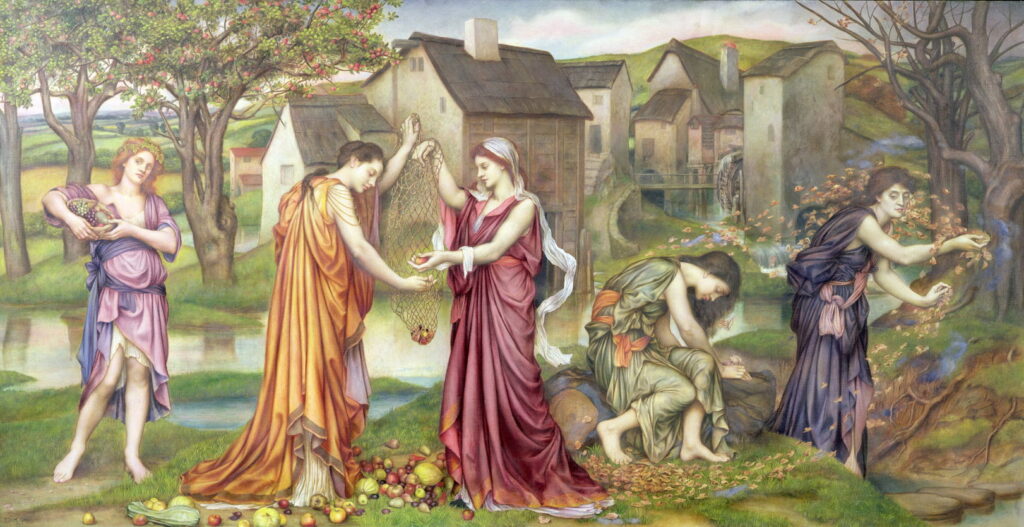The Real Country: The Year

For those working the land to grow crops, the start of the year was after the harvest was complete, when the first cooler days of autumn came in, before rain turned the fields and tracks to mud, and the winter’s frosts began. This was the time to start preparing arable fields for the growing season next year, with their first ploughing.
Robert Bevan (1865–1925), The Turn Rice-Plough, Sussex (c 1909), oil on canvas, 66.4 x 90.2 cm, Yale Center for British Art, New Haven, CT. Wikimedia Commons.
Robert Bevan’s The Turn Rice-Plough, Sussex from about 1909 shows two ploughmen turning a plough in a field in the south-east of England. Its title is probably a simple error for turnwrest, a dialect name used in Kent and Sussex to describe any type of one-way plough that needed to be turned at the end of a furrow as shown here.
Depending on the soil, weather and intended crop, this could be the first of more than five sessions with the plough, before the seed could be sown.
Benjamin Williams Leader (1831–1923), February Fill Dyke (1881), oil on canvas, dimensions not known, Birmingham Museums Trust, Birmingham, England. Wikimedia Commons.
Pastures by rivers were often encouraged to flood during the winter, particularly in the month of February Fill Dyke as shown so well in Benjamin Williams Leader’s painting of country near Worcester in 1881. This both improved soil fertility and kept weeds at bay.
Jean-François Millet (1814–1875), The Sower (c 1865), pastel and crayon on paper or pastel and pastel on paper (cream buff paper), 43.5 × 53.5 cm, Walters Art Museum, Baltimore, MD. Wikimedia Commons.
Jean-François Millet revisited his successful painting of a sower from fifteen years earlier in two pastel paintings with the same title, The Sower, from around 1865. In the distance to the right are two horses drawing a spike harrow, used following ploughing to prepare the surface of the earth for seed.
Once the young plants were growing vigorously, all that remained for the growing season was to keep them free from weeds, a laborious and back-breaking task commonly assigned to women.
Jules Breton (1827–1906), The Weeders (1868), oil on canvas, 71.4 × 127.6 cm, The Metropolitan Museum of Art, New York, NY. Wikimedia Commons.
Jules Breton’s The Weeders from 1868 is set in the fields just outside his home village of Courrières, where these labourers are pulling up thistles and other weeds until the moment the light becomes insufficient for them to work any longer.
Farmers with sheep or cattle usually timed the arrival of the lambs and calves for the spring, to give the young animals as much benefit as possible from the fine weather of the summer.
Rosa Bonheur (1822–1899), Weaning the Calves (1879), oil on canvas, 65.1 × 81.3 cm, The Metropolitan Museum of Art, New York, NY. Wikimedia Commons.
Rosa Bonheur’s Weaning the Calves (1879) is set in a glorious summer Alpine or Pyrenean landscape, with a dry stone herdsman’s hut at the left, where the menfolk lived while they were away from their families during the summer transhumance to upland grazing.
Anton Mauve (1838–1888), The Return of the Flock (1886-7), oil on canvas, 100.2 x 161.4 cm, Philadelphia Museum of Art, Philadelphia, PA. Wikimedia Commons.
Anton Mauve’s Return of the Flock (1886-7) shows a small flock of unshorn ewes with young lambs, on the move in the late Spring or early summer.
In some cattle areas at least, once the Spring lambs and calves had been safely delivered into the care of their mothers, couples took the opportunity to get married, as confirmed by analyses of English parish registers. For those growing crops, though, there was little respite during the growing season, when fields had to be kept free of weeds before harvest.
By the end of the Spring or early summer, sheep and cattle were moved to summer grazing to allow the grass in hay meadows to grow ready for mowing during July or August, depending on the latitude and weather.
Mykola Pymonenko (1862–1912), Haymaking (date not known), oil on canvas, dimensions not known, Fine Arts Museum Kharkiv Харківський художній музей, Kharkiv, Ukraine. Wikimedia Commons.
Mykola Pymonenko’s undated Haymaking shows women in Ukraine raking in the harvest to be transported by a hay wain drawn by a pair of oxen.
Samuel Palmer (1805–1881), The Shearers (c 1833-5), oil and tempera on wood, 51.4 x 71.7 cm, Private collection. WikiArt.
Samuel Palmer’s Shearers from about 1833-35 shows the seasonal work of a shearing gang, relieving these adult sheep of their fleece before the weather became too hot.
Meanwhile, the summer’s grain crop ripened and was ready for harvest.
Pieter Brueghel the Elder (1526/1530–1569), The Harvesters (1565), oil on panel, 119 x 162 cm, Metropolitan Museum of Art, New York, NY. Wikimedia Commons.
Pieter Brueghel the Elder’s Harvesters from 1565 includes most of the outdoor stages from cutting the grain using scythes to transporting the harvest by cart for threshing.
Once the harvest was home, demands on the arable farmer eased, and some English parish records show a peak of marriages during the early autumn in areas predominantly farming sheep and grain. This was also the time for the harvest of fruit such as apples.
Camille Pissarro (1830–1903), Apple-Picking, Éragny (1887-1888), oil on canvas, 60.9 x 73.9 cm, Dallas Museum of Art, Dallas, TX. Wikimedia Commons.
Camille Pissarro’s overtly Divisionist painting of Apple Picking, Éragny, was largely completed during the autumn of 1887.
Evelyn De Morgan (1855–1919), The Cadence of Autumn (1905), oil on canvas, dimensions not known, The De Morgan Centre, Guildford, Surrey, England. Wikimedia Commons.
This decisive phase of the year is shown well in Evelyn De Morgan’s Cadence of Autumn from 1905, here centred on the fruit harvest. Five women are shown in a frieze, against a rustic background. From the left, one holds a basket of grapes and other fruit, two are putting marrows, apples, pears and other fruit into a large net bag, held between them. The fourth crouches down from a seated position, her hands grasping leaves, and the last is stood, letting the wind blow leaves out from each hand. They wear loose robes coloured in accordance with their phases in the season.
The landscape behind them contains a watermill and surrounding buildings. At the left, the trees are heavy with fruit and the fields either green or ripe corn. At the right, the trees are barren, and the landscape hilly and more wintry. Soft blue-white patches of mist are visible in the foreground on the right. The passing of the season, and the fruit harvest, progresses in time from the left to the right.
By that time, the first fields were being ploughed in preparation for the following year.
Before the nineteenth century, when many farms either concentrated on sheep and arable, or on the raising of cattle, their economies were contrasting. The arable farmer was committed to labour-intensive work and investment throughout the year, with any cash return occurring once the harvest had been sold. Livestock farmers had lower labour requirements for much of the year, with their peak demand during Spring calving, and could spread the sale of animals more evenly over the year, with more immediate returns on their investment. This also enabled those involved in livestock farming to have more free time to engage in crafts and other sidelines.


